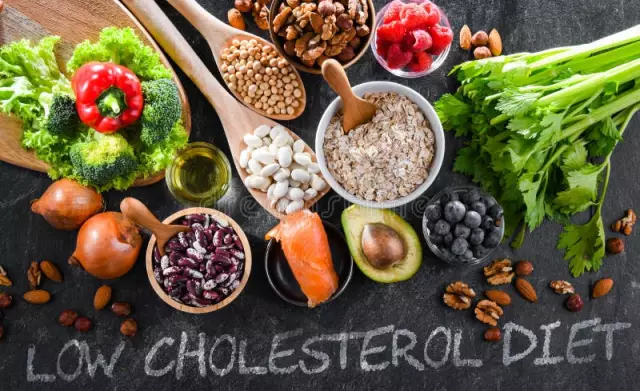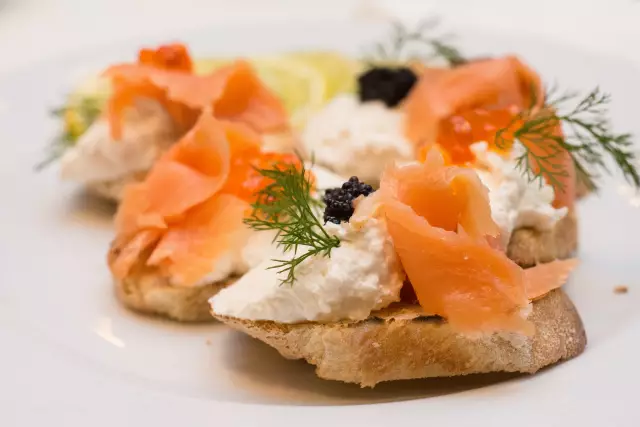- Author Rachel Wainwright [email protected].
- Public 2023-12-15 07:39.
- Last modified 2025-11-02 20:14.
Cholesterol diet

Cholesterol is an organic compound that is vital for every living organism to exist. 80-90% of all cholesterol in our body is produced by our own cells. Another 10% comes from food. A high level of total cholesterol according to blood biochemistry is a risk factor for the development of cardiovascular diseases. This is primarily true for coronary heart disease, and therefore heart attacks. A cholesterol diet aims to lower blood cholesterol levels. In the menu of the cholesterol diet, there are no sources of this substance - animal fats. In addition, the diet is rich in foods that normalize the body's metabolism and reduce the production of excess cholesterol by cells. Weight loss can be considered a positive effect of such a diet. Thus, this power system also removes extra pounds,and improves health. Dishes for cholesterol diet recipes can be found on the Internet and in special literature.
Principles of the cholesterol diet
The diet can be less (step 1) or more strict (step 2).
Stage number 1. The total fat in the diet should not exceed 30% of the total calorie content, saturated fatty acids - 10% of the total calorie content, the daily intake of cholesterol should not exceed 300 mg. The daily consumption of meat and fish is limited to 180 grams (no more than 90 grams per meal). Fat is carefully cut off from meat, skin is removed from poultry. Exclude butter and hard margarines. Milk, kefir, cottage cheese are allowed only low-fat. Vegetable oil should be present on the cholesterol diet menu. It should account for no more than 10% of the calorie content of the daily diet. Egg yolk and offal (liver, kidneys, brains) should be completely excluded. Carbohydrates should make up 55-60% of all food. Preference is given to foods rich in fiber (fruits, vegetables, bread, toast, muesli,cereals and other whole grains). You can stick to the number 1 diet of the cholesterol diet for 6-12 weeks. If you are satisfied with the results, then you should move on to a balanced healthy diet for age. In the event that a decrease in blood cholesterol has not occurred, then it is necessary to proceed to step number 2 of the cholesterol diet. In this case, the total fat content remains the same, while the content of saturated fatty acids is reduced to 7% of the caloric content of the diet, and cholesterol to 200 mg per day. The second stage diet should be introduced gradually, preferably under the supervision of an endocrinologist, nutritionist or general practitioner.if a decrease in blood cholesterol has not occurred, then you need to move on to step number 2 of the cholesterol diet. In this case, the total fat content remains the same, while the content of saturated fatty acids is reduced to 7% of the caloric content of the diet, and cholesterol to 200 mg per day. The second stage diet should be introduced gradually, preferably under the supervision of an endocrinologist, nutritionist or general practitioner.if a decrease in blood cholesterol has not occurred, then you need to move on to step number 2 of the cholesterol diet. In this case, the total fat content remains the same, while the content of saturated fatty acids is reduced to 7% of the caloric content of the diet, and cholesterol to 200 mg per day. The second stage diet should be introduced gradually, preferably under the supervision of an endocrinologist, nutritionist or general practitioner.
Cholesterol diet menu

It is worth eating several times a day, in small portions. Eat slowly and chew food thoroughly. Eating in front of the TV, a computer is not recommended. An approximate cholesterol diet menu is as follows:
- Breakfast (option 1): a glass of low-fat kefir, grain bread, boiled carrots;
- Breakfast (option 2): a glass of freshly squeezed juice from any fruit. Cottage cheese 5% 150 grams;
- Breakfast (option 3): boiled beans 100 grams and grain bread 25 grams;
- Lunch (option 1): boiled chicken meat 90 grams. Cereal bread 25 grams. Vegetables with vegetable oil;
- Lunch (option 2): low-fat cheese 50 grams. Cereal bread 25 grams. Spiced vegetables;
- Lunch (option 3): pollock 90 grams. Boiled potatoes 100 grams. Apple;
- Dinner (option 1): lean buckwheat porridge 50 grams. Chicken 90 grams. Cabbage salad with vegetable oil;
- Dinner (option 2): low-fat cottage cheese 200 grams. Apple. Cereal bread 25 grams;
- Dinner (option 3): boiled potatoes 100 grams. Boiled fish 90 grams. Orange.
You can use a variety of breakfast, lunch and dinner options throughout the week. For afternoon tea and lunch, always eat vegetables and fruits. If you really want something sweet, take those confectionery products that do not contain fats. For example, you can eat a spoonful of honey, or one marshmallow, or 50 grams of marmalade. As you can see, cholesterol diet recipes are very simple and affordable for any level of culinary ability.
Found a mistake in the text? Select it and press Ctrl + Enter.






